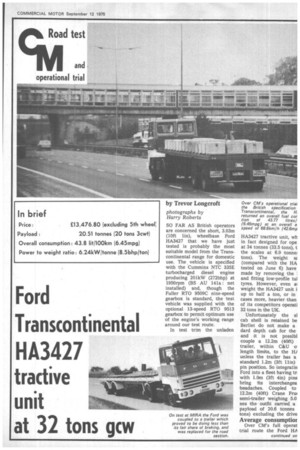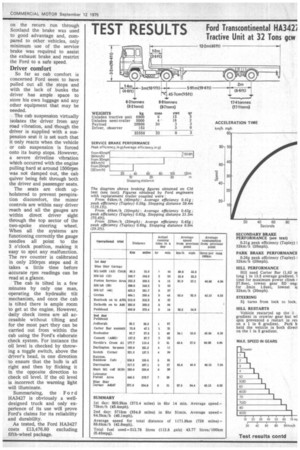Ford Transcontinenta HA3427 tractive unit at 32 tons gcw
Page 41

Page 42

Page 43

If you've noticed an error in this article please click here to report it so we can fix it.
by Trevor Longcroft
photographs by Harry Roberts SO FAR AS British operators are concerned the short, 3.03m (10ft lin), wheelbase Ford HA3427 that we have just tested is probably the most suitable model from the Transcontinental range for domestic use. The vehicle is specified with the Cummins NTC 335E turbocharged diesel engine producing 201kW (272bhp) at 1950rpm (BS AU 141a: net installed) •and, though the Fuller RTO 9509C nine-speed gearbox is standard, the test vehicle was 'supplied with the optional 13-speed RTO 9513 gearbox to permit optimum use of the engine's working range around our test route.
In test trim the unladen
Over CM's operational trial the British specification Transcontinental, the H. returned an overall fuel cor tion of 43.77 litres! (6.45mpg) at an overall a speed of 68.6km/h (42.6mp
HA3427 tractive unit, wh in fact designed for ope at 34 tonnes (33.5 tons), t the scales at 6.9 tonne: tons). The weight sz (compared with the HA tested on June 6) have made by removing the I and fitting low-profile tul tyres. However, even a1 weight the HA3427 unit up to half a ton, or in cases more, heavier than of its competitors operati 32 tons in the UK.
Unfortunately the sl cab shell is retained be Berliet do ntit make dard depth cab for the and it is not possibl couple a 12.2m (40ft) trailer, within C&U length limits, to the 11) unless the trailer has 'a standard 1.2m (3ft 1 lin) pin position. So integratin Ford into a fleet having tr with 1.0m (3ft 4in) pins bring Its interchangea headaches. Coupled to 12.2m (4010 Crane Fru( semi-trailer weighing 5.0 nes the outfit carried a payload of 20.6 tonnes tons) excluding the drive
Average consumptior
Over CM's full operat trial route the Ford HA Tried an overall fuel con.ption of 43.77 litres/100km 5mpg) which we consider e the norm for this class of icle on this route. But this gumption was achieved at overall average speed of km/h (42.6mph), the total ance of 1171km (728 miles) ig covered in a fraction r 17hr driving time. The I HA4231 tested earlier year is one of the few icles to have outpaced the 3427, and then at a con:I-able fuel cost. Also, had HA3427 not had to contend a unusually heavy traffic the first leg on MI and M6 the rash of single line Sc operation on M6 and .he base of the MI in both !otions, average speed and sibly fuel consumption ild have shown marginal rovements.
,ngine power proved to be ?.fully matched by the 13ed gearbox and the high o 3.7 to I rear axle to give Ford the ability to cruise peeds in the high fifties on orways with the engine ling over at a r o un d Orpm yet still be able to :art without effort on a 1 in radient.
In motorway work the Ford cally held eighth gear, using splitter to slip between !ct and overdrive to mainr optimum speeds close to legal limit. It was only essary to drop into seventh r, or in one case sixth, for steeper climbs or when I up by slower moving ;ks or cars towing caravans. ! Keele gradient was climbwith 'seventh o/d engaged h the speed dropping to around 43mph toward the brow of the hill; on the steepest section of the Shepshed "Slow lorries" section on M1 sixth o/d was required to complete the climb, with the vehicle speed dropping to 30mph.
Sensible use of the 13-speed gearbox also showed dividends on, the steep hill climbs, the well-specified ratio steps allowing the driver to keep the engine turning over in the section of the rev band above 130Orpm.
Carter Bar was climbed in fine style in 4min 37.9sec with fifth o/d being engaged for three-quarters of the climb; typical speed was around 25mph, dropping to 20mph on the steepest section. At 20mph in fifth o/d the engine was revving at 1400rpm — or 100rpm above the peak torque speed.
During the full-pressure brake tests on the MIRA proving grounds, when stopping from 64km/h (40mph) the outfit veered violently to the offside and almost jack-knifed. Investigations showed that the instability and the poor brake figures achieved were caused by lack of braking effort from the trailer. In the interests of safety the 'trailer was changed for the road section of the test. Braking figures 'subsequently obtained by Ford engineers with the replacement trailer 'coupled to the unit have been given, in addition to our own original results, in the test panel.
Elide and handling
The sheer bulk of the Tnanscontinental cab gives the impression that 'the vehicle is unwieldy but in fact the opposite is the case. The integral power steering is backed up by an auxiliary ram on the nearside and this combination provides for finger-light 'Steering which, after initial uncertainty, I quickly warmed to. Steering is delightfully direct and accurate, 'the ability to pass an oncoming truck, on a road barely wide enough for two vehicles, with a casual flick of the wrist to correct course, certainly inspires driver confidence.
The 13-speed 'gearbox is also easy to handle and even the inexperienced driver should have no trouble in quickly coming Ito terms with it. The box has the conventional sixspeed gate, with crawler and reverse at opposite ends of the first slot and the remaining 12 ratios shared between the other four 'positions. The basic pattern is that of :a private car, the range or split being selected on the lever control. There are four gears in the low range and four in the high and each gear in high can be split into either direct or overdrive. For optimum speeds, the engine revs are best kept between around 1500rpm and the rated speed of 1950rpm; changing a whole gear gave 500rpan, the split change around 250rpm. When splitting on the button only, some care was needed •to ensure first-time engagement, especially changing from overdrive to direct. The procedure is to preselect the direct drive and then declutch to engage. However, if the declutch was carried out too smartly the gear was occasionally missed and when climbing gradients the advantage of a slick change lost.
Some caution was also required when operating the clutch as the last part of the pedal travel actuated the clutch stop. So when changing normally it was only necessary to depress the pedal a couple of Inches; for a quick change, such as required on steep gradients, without doubling the clutch, the pedal is floored and the lever shifted rapidly through the gate.
Once the position of the clutch stop on the pedal was defined there was little excuse for poor changes.
The slide exhaust brake fitted to the Ford is one of the most effective that I have used, though when at full ° stretch it was very noisy. On the long descents encountered on the return run through Scotland the brake was used to good advantage and, compared to other vehicles, only minimum use of the service brake was required to assist the exhaust brake and restrict the Ford to a safe speed.
Driver comfort
So far as cab comfort is concerned Ford seem to have pulled out all the stops and with the lack of bunks the driver has ample space to store his own luggage and any other equipment that may be needed.
The cab suspension virtually isolates the driver from any road vibration, and though the driver is supplied with a suspension seat it is set such that it only reacts when the vehicle or cab suspension is forced onto its bump stops. However, a severe driveline vibration which occurred with the engine pulling hard at around 1500rpm was not damped out, the cab quiver being felt through both the driver and passenger seats.
The seats are cloth upholstered to to prevent perspiration discomfort, the minor controls are within easy driver • reach and all the gauges are within diredt driver sight through the top sector of the two-spoke steering wheel. When all the systems are functioning correctly the gauge needles all point to the 3 o'clock position, making it easy to spot any malfunction. The rev counter is calibrated in only 250rpm steps and it takes a little time before accurate rpm readings can be read at a glance.
The cab is tilted in a few minutes by only one man, operating the hydraulic tilt mechanism, and once the cab is tilted there is ample room to get at the engine. However, daily check items are all accessible without tilting and for the most part they can be carried out from within the cab using the Ford's elaborate check system. For instance the oil level is checked by throwing a toggle switch, above the -driver's head, in one direction to ensure that the bulb is all right and then by flicking it in the opposite direction to check oil level. If the oil level is incorrect the warning light will illuminate.
Summarising, the Fo rd HA3427 is oibviously a welldesigned truck and only experience of its use will prove Ford's claims for its reliability and durability.
As tested, the Ford HA3427 costs £13,476.80 excluding fifth-wheel package.
















































































































